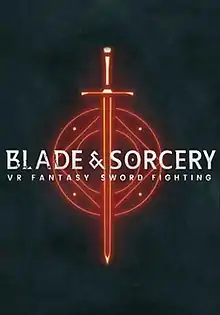Blade and Sorcery
Blade and Sorcery is a medieval fantasy simulation sandbox game developed and published by French independent studio WarpFrog, made exclusively for virtual reality. Combat and environmental interactions are driven by full physics simulation. The game released in early access in 2018.[1]
| Blade and Sorcery | |
|---|---|
 | |
| Developer(s) | WarpFrog |
| Publisher(s) | WarpFrog |
| Engine | Unity |
| Platform(s) | Microsoft Windows, Meta Quest |
| Release | December 11, 2018 (Early access) |
| Genre(s) | Fighting video game |
| Mode(s) | Single-player |
Gameplay
The player starts Blade and Sorcery by creating their character, choosing what they look like and wear. The character then spawns in a house where they can test weapons and select an arena. Once in one, the player can select what to fight against, choosing between different difficulties and special modes.
The main gameplay mode available is sandbox mode, with a "Progression mode" coming on full release. In sandbox, the player can spawn and fight waves of enemies in arena type maps, spawn various weapons, and have access to mods and a dev mode (cheats). When spawning enemies, the player can choose the difficulty of the wave, impacting things such as armour class of the enemy and amount that spawn. The enemies then spawn in waves, trying to kill the player using different weapons.
There are three types of enemies: ranged, mage and melee fighters. Melee fighters include axes, swords, mace users and more. Ranged enemy have bows and arrows, as well as a melee sidearm. Mages attack with lighting and fireballs. The player can hit enemies with thrown objects like weapons or physics objects, or can directly use weapons to hit enemies. They can also use magic to electrocute or burn enemies. Each warrior can take a certain number of hits, depending on whether they get hit or get stabbed by a weapon. The player can also dismember enemies by targeting specific points on their body, like the neck or the joints.[2]
Development
Blade and Sorcery started development in 2016 as a multiplayer project in Unity called "Sorcering";[3] a teleport-only game where the player fought waves of the undead using magic. The developer, KospY, had previously worked on mods for Kerbal Space Program and Fallout 3 which helped him learn Unity and how to program.[4] He chose to develop for VR out of an interest in the emerging technology and the prospects VR allowed in innovation for more experimental games. This led to the decision of making a game that was a full physics simulation sandbox first and foremost,[5] the first of its kind in VR. The decision to add melee combat came afterwards, and grew organically when the physics simulation proved to be engaging and lend itself to innovative melee combat in VR.[6]
The original multiplayer concept design for Sorcering was abandoned when it became evident that high lag with physics made it unsatisfying to fight human enemies, and the small VR user base made it hard to justify a multiplayer only VR game.[7] After two years of creating the prototype, KospY left his job and started working full-time on the project which now became Blade and Sorcery. He used the extra time to rewrite the game's code from scratch, making the codebase easier to use and run faster. The new direction of the game would be a single-player game, focusing on melee and magic built on the physics simulation sandbox KospY had created. He later talked about the process, "It took me nearly 6 months, but I don’t regret any of it whatsoever; and Blade & Sorcery is now a good foundation to build upon it."
When asked about being a solo dev, he said the greatest challenge was not being able to focus on multiple things at once, instead having to work on one feature at a time. The visuals were inspired by games such as The Elder Scrolls V: Skyrim and Dark Messiah. Not being an artist, KospY originally used premade assets for the game and tried to choose ones that fit the game the best. As the WarpFrog team grew, piece by piece store-made assets were replaced with custom built ones, with the most dramatic graphical changes appearing at U8.[8]
Early access updates have added new weapons and additional magic spells.[9] As of U10, sandbox game mode also features "Dungeons"; a semi-procedurally generated dungeon crawl with prespawned enemies.[10][11] Multiplayer could be added to the game at some point, but it's unclear if the feature will make the cut.[12][13]
References
- "Blade and Sorcery on Steam". store.steampowered.com. Retrieved 2021-09-28.
- Horti, Samuel (2018-12-15). "Blade and Sorcery's glorious VR violence makes me feel guilty for every stab". PC Gamer. Retrieved 2021-09-28.
- Pitchford, Jordan (2019-04-12). "Blade & Sorcery: How One Man Redefined VR Melee Combat Physics". Retrieved 2022-01-18.
- "Modder to Developer - KospY". Nexus Mods :: News :: Interviews. Retrieved 2022-01-18.
- DEVChats - Blade & Sorcery: Nomad - An Interview to Cut to the Chase on Easter Eggs, Mods, and more!, retrieved 2022-01-18
- Pitchford, Jordan (2019-04-12). "Blade & Sorcery: How One Man Redefined VR Melee Combat Physics". Retrieved 2022-01-18.
- Pitchford, Jordan (2019-04-12). "Blade & Sorcery: How One Man Redefined VR Melee Combat Physics". Retrieved 2022-01-18.
- "Blade and Sorcery - Update 8: The Sorcery Update, is released! - Steam News". store.steampowered.com. 2020-06-04. Retrieved 2022-01-18.
- "Blade & Sorcery launches big update June 4 on Oculus and Steam (correction)". VentureBeat. 2020-05-31. Retrieved 2021-09-28.
- Lang, Ben (2021-09-01). "'Blade & Sorcery' Dungeons Teaser Reveals Sprawling Interiors". Road to VR. Retrieved 2021-09-27.
- "U10 - The Dungeons Update, is now available! :: Blade & Sorcery Events & Announcements". steamcommunity.com. Archived from the original on 2021-10-28. Retrieved 2022-01-18.
- Pitchford, Jordan. "Blade & Sorcery: How One Man Redefined VR Melee Combat Physics". Retrieved 2021-09-27.
- VR, Oculus. "Magic Meets Melee with 'Blade & Sorcery,' Available Now on Rift". www.oculus.com. Retrieved 2021-09-27.